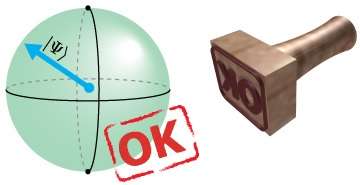November 11, 2013 feature
Physicists 'uncollapse' a partially collapsed qubit

(Phys.org) —One of the striking features of a qubit is that, unlike a classical bit, it can be in two states at the same time. That is, until a measurement is made on the qubit, causing it to collapse into a single state. This measurement process and the resulting collapse may at first seem irreversible. (Once you open the box to find a dead cat, there's no going back, right?) But recently physicists have been investigating the possibility of "uncollapsing," or recovering the state of, a qubit that has been partially collapsed due to a weak measurement. The results could be used for implementing quality control in quantum systems.
In a new paper published in Physical Review Letters, physicists J. A. Sherman, et al., at the University of Oxford, have experimentally demonstrated a recovery method that can restore the state of a single qubit, in principle perfectly, after it has partially collapsed.
As the physicists explain, a full collapse of a qubit results from a measurement that reveals the qubit's state, while a partial collapse results from a measurement that can be thought of as a "peek" at the qubit because it doesn't reveal the qubit's state, but simply verifies that the qubit hasn't decayed. The problem is that, often the mere act of peeking alters the qubit's state. A recovery method would essentially reverse the effects of peeking on the qubit, thereby allowing peeking to serve as a sort of non-destructive quantum quality control technique.
The concept of a partial collapse can also be imagined in terms of Schrödinger's cat.
"To really torture the cat analogy, imagine the cat could be in three states: happy, sad, or dead," Sherman told Phys.org. "Then the technique is a way to measure just whether the cat is dead or not without learning anything at all about whether the cat is either happy or sad. The precise quantum mixture of happy and sad is actively recoverable even after verifying that the cat isn't dead.

"Once we look inside, the cat will be found either dead or alive, constituting a 'full collapse' of its state. There is no recovering a cat found dead, and likewise there is no repairing quantum information after it is found collapsed."
The physicists explain that the qubit recovery method can be thought of as a generalization of a concept called spin echo, which can be considered as a way to "unwind" a spin rotation. The method was proposed in 2002 by L.-A.Wu, et al., and experimentally realized for the first time by N. Katz, et al., in 2008.
Here, the physicists have improved the accuracy of this method by reducing the infidelity by an order of magnitude. The improvements enabled them to achieve substantial recovery of a qubit's state for relatively large partial collapses. For instance, even with an 80% probability of decay, the information content of the qubit is preserved with an accuracy greater than 98%.
However, the recovery method is not perfect. The probability of recovering the qubit's state depends on how much it has collapsed, so that the more collapsed the qubit is, the less likely it is to recover. A fully collapsed qubit has zero probability of recovery.
Still, the recovery method could be very useful for overcoming one of the biggest challenges in developing quantum systems: decoherence, which results in the loss of a system's quantum properties.
"The source of great interest in quantum information is also its biggest weakness: quantum coherence is fragile since all quantum systems are greatly affected by noisy environments and spontaneous decay," Sherman said. "To make sophisticated use of quantum information, we need methods of detecting and correcting these random errors. The 'reversible peek' we describe is universally applicable, and is most helpful in cases where one qubit state decays much faster (or is more sensitive to noise) than the other. For photonic qubits, the 'reversible peek' can be implemented with birefringent optics and polarizers. For qubits formed from superconductors, it can be realized with microwave pulses. For atomic qubits like ours, we employed optical and radio-frequency pulses. The 'reversible peek' may be one of several techniques which promote any of these quantum computation architectures from a laboratory curiosity to a real, widely deployable, useful device."
In the future, the physicists plan to continue working on ways to use the qubit recovery method for different purposes.
"Ideally, the 'reversible peek' could become a standard and widely used part of any quantum mechanic's toolbox," Sherman said. "Consider the spin-echo. Viewed one way, a spin-echo is a correction procedure for an unwanted qubit phase shift. But far from being an academic novelty, the spin-echo finds use in nearly every quantum information experiment, to say nothing about its routine role increasing signal levels in every hospital's magnetic resonance imaging (MRI) machine. (I guess about one-third of the loud noises one hears in an MRI machine are caused by spin-echo pulses.) The 'reversible peek' we investigated has a structure very much like a spin-echo, but is designed to detect and correct for a different sort of qubit error: spontaneous decay."
In the future, the Oxford group will continue investigating many methods of making quantum computation with trapped atomic ions more scalable and robust. In this context, the 'reversible peek' quality-control technique may be among several innovations which together make a quantum computation system practical, which is the ultimate goal.
More information: J. A. Sherman, et al. "Experimental Recovery of a Qubit from Partial Collapse." Physical Review Letters. DOI: 10.1103/PhysRevLett.111.180501
Journal information: Physical Review Letters
© 2013 Phys.org. All rights reserved.





















